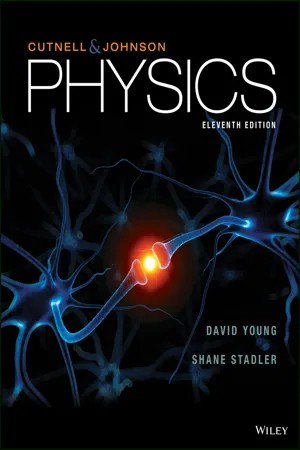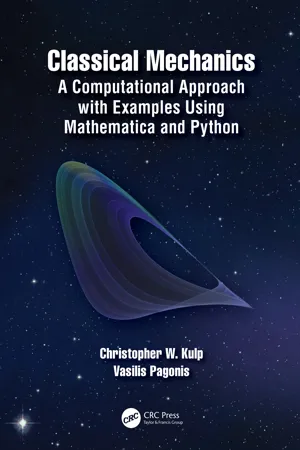Mathematics
Constant Acceleration Equations
Constant acceleration equations are mathematical formulas used to describe the motion of an object with a constant acceleration. These equations include the equations of motion, such as the equations for displacement, velocity, and acceleration, under constant acceleration. They are commonly used in physics and engineering to analyze the motion of objects under the influence of gravity or other forces.
Written by Perlego with AI-assistance
Related key terms
6 Key excerpts on "Constant Acceleration Equations"
- David V. Guerra(Author)
- 2023(Publication Date)
- CRC Press(Publisher)
(7.3)The SI unit for acceleration is (m/s)/s, which is usually written m/s2 .For example, as shown in Figure 7.5 , if a car is traveling northward at 10 m/s and speeds up to 30 m/s northward in 5 seconds, the average acceleration during those 5 seconds is:= ( 30 m/s northward – 10 m/s northward ) / ( 5 seconds ) = 4a ⇀Avg01m/s 2northward .FIGURE 7.5 Example of constant acceleration.If, during the 5 seconds in which the car is speeding up, the car increases its speed (without changing the direction of its velocity) at a constant rate, the acceleration is said to be constant and the acceleration at any instant in time during those 5 seconds will be the same as the average acceleration.When a rigid body undergoes purely translational motion, every part of the body undergoes the same motion, but different parts move along different curves or lines. When studying the motion of a rigid body, to determine the motion of the object, it is common to track the motion of the rigid body’s center of mass.7.2.1 One-Dimensional Motion
For this and the next few chapters, the motion studied will be along a line in one-dimension. It is common to choose our x-y-z coordinate system so that the x-axis or y-axis is along the line in which the motion occurs. Then, the motion will only have one component of displacementvelocityd ⇀,and accelerationv ⇀,a ⇀, such as the x-components, dx , vx, ax , or the y-components, dy , vy, ay- eBook - ePub
- D. Gordon E. Robertson, Graham E. Caldwell, Joseph Hamill, Gary Kamen, Saunders Whittlesey(Authors)
- 2013(Publication Date)
- Human Kinetics(Publisher)
It is also the starting place for a complete kinematic description of any human motion. In this section, we introduce the kinematic variables of displacement, velocity, and acceleration, all of which describe the manner in which the position of a point changes over a period of time. The mathematical processes of differentiation and integration—the main concepts of calculus—relate these kinematic variables. Displacement is defined as the change in position. Velocity is the time derivative of displacement, defined as the rate of change of displacement with respect to time. Acceleration is the time derivative of velocity, defined as the rate of change of velocity with respect to time. Acceleration is therefore the second derivative of displacement with respect to time. These three kinematic variables can be used to understand the motion characteristics of a movement, to compare the motion of two different individuals, or to show how motion has been affected by some intervention. Sometimes, determining the time derivative of acceleration, called jerk, is desirable to assess the severity of head impacts during car crashes or collisions with surfaces or projectiles. Table 1.2 lists the commonly used kinematic measures and their associated symbols and units in the International System of Units (SI), including angular kinematic variables, which are discussed later. In some situations, acceleration can be measured directly with a device aptly called an accelerometer. Integral calculus is then used to find the velocity and displacement data. Velocity is the first integral of acceleration with respect to time, whereas displacement is the integral of velocity with respect to time. Information on accelerometers is presented later in this chapter, and methods of integration are detailed in the section on the impulse-momentum relationship in chapter 4 - eBook - ePub
- John D. Cutnell, Kenneth W. Johnson, David Young, Shane Stadler(Authors)
- 2018(Publication Date)
- Wiley(Publisher)
Equation 2.3 .(2.1)Average speed =(2.2)Distance Elapsed time(2.3)=v →‾Δx →Δ tv →=limΔ t → 0Δx →Δ t- 2.3 Acceleration The average acceleration
is a vector. It equals the changea →‾Δin the velocity divided by the elapsed timev →Δt, the change in the velocity being the final minus the initial velocity; see Equation 2.4 . WhenΔtbecomes infinitesimally small, the average acceleration becomes equal to the instantaneous accelerationa →, as indicated in Equation 2.5 . Acceleration is the rate at which the velocity is changing. (2.4)(2.5)=a →‾Δv →Δ ta →=limΔ t → 0Δv →Δ t- 2.4
Equations of Kinematics for Constant Acceleration/2.5 Applications of the Equations of KinematicsThe equations of kinematics apply when an object moves with a constant acceleration along a straight line. These equations relate the displacementx − x0, the acceleration a, the final velocity v, the initial velocity v0 , and the elapsed timet − t0. Assuming thatx0 = 0 matt0 = 0 s, the equations of kinematics are as shown in Equations 2.4 and 2.7–2.9. (2.4)v =(2.7)v 0+ a tx =(2.8)1 2(t)v 0+ vx =(2.9)v 0t =1 2at 2v 2=v 0 2+ 2 a x- 2.6 Freely Falling Bodies In free-fall motion, an object experiences negligible air resistance and a constant acceleration due to gravity. All objects at the same location above the earth have the same acceleration due to gravity. The acceleration due to gravity is directed toward the center of the earth and has a magnitude of approximately
9.80 m/s2near the earth's surface.- 2.7 Graphical Analysis of Velocity and Acceleration
- eBook - ePub
Classical Mechanics
A Computational Approach with Examples Using Mathematica and Python
- Christopher W. Kulp, Vasilis Pagonis(Authors)
- 2020(Publication Date)
- CRC Press(Publisher)
Choosing t 0 = 0 and performing the integral results in: x (t) = 1 2 a t 2 + v 0 t + x 0 (2.3.9) Together, equations (2.3.4) and (2.3.9) are the only equations you need to know, in order to solve for the position and velocity of a particle moving in one-dimension and experiencing a constant net force. Finally, if we want v (x) we can solve. (2.1.4): v d v d x = F 0 m (2.3.10) v d v = a d x (2.3.11) ∫ v 0 v v ′ d v ′ = a ∫ x 0 x d x ′ (2.3.12) v 2 − v 0 2 = 2 a (x − x 0) (2.3.13) where a = F 0 / m was used in (2.3.11). We could have also obtained this result by eliminating t between equations (2.3.3) and (2.3.9). The box below summarizes all of the constant force equations, sometimes called the kinematic equations. These are equations that you should memorize. kinematic equations (a=constant) v (t) = v o + a t (2.3.14) x (t) = x o + v o t + 1 2 a t 2 (2.3.15) v (x) 2 = v o 2 + 2 a (x − x o) (2.3.16) In the case of a freely falling particle near the surface of the Earth, we use a = − g = − 9.8 m / s 2 (assuming “down” is in the negative direction), where g is the acceleration due to gravity. The kinematic equations become: v (t) = v 0 − g t (2.3.17) y (t) = y 0 + v 0 t − 1 2 g t 2 (2.3.18) v (y) 2 = v 0 2 − 2 g (y − y 0) (2.3.19) We used y as the position variable, which is common when describing vertical motion. Notice that these are not different equations from the kinematic equations but simply the kinematic equations with a specific value of a. We now look at some well-known examples of situations in which the acceleration of the system is constant. Example 2.1: The Atwood machine The Atwood machine consists of two masses m 1, m 2 hanging over a pulley as shown in Figure 2.1. Assume that m 2 > m 1. Find the acceleration a of the masses and the tension of the string. Figure 2.1: The free body diagrams of the two hanging masses of the Atwood machine. Solution: We can derive an equation for the acceleration by using force analysis - eBook - ePub
Doing Physics with Scientific Notebook
A Problem Solving Approach
- Joseph Gallant(Author)
- 2012(Publication Date)
- Wiley(Publisher)
If the displacement and velocity have the same sign, the object is moving away from the origin. If they have opposite signs, the object is moving toward the origin.Table 2.2 summarizes the sign information for velocity and acceleration for horizontal motion.Table 2.2
If the velocity and the acceleration have the same sign, the object’s speed is increasing. If they have opposite signs, the object is slowing down. For vertical motion, just replace the word “right” with “up” and replace the word “left” with “down” in both tables.Velocity Acceleration Interpretation Positive Positive Moving right, speed increasing Positive Negative Moving right, speed decreasing Negative Positive Moving left, speed decreasing Negative Negative Moving left, speed increasing Free Fall
One famous and important example of constant acceleration motion is the motion of an object under the influence of gravity near the Earth’s surface. This vertical acceleration is a = - g where g = 9.8067 m/ s2 is the acceleration’s magnitude and the minus sign indicates gravity acts down. Because the acceleration due to gravity is approximately constant, all objects fall at the same constant rate.When gravity is the only force acting on an object, we say it is in free fall. As long as the object is not too light or moving too fast, air resistance is negligible and gravity determines its motion. An object is in free fall as soon as it is released, whether it is dropped or thrown, whether it is going up or down.We can apply Eqs. (2.5) to this problem. To distinguish horizontal motion from vertical, let’s rewrite the equations of motion letting y denote vertical position (height). When you change x → y and let a = - g, you have the following four equations.(2.6a)(2.6b)(2.6c)(2.6d)These four equations describe the motion of an object that is dropped or thrown straight up or down under the influence of gravity with negligible air resistance. They relate the object’s height and vertical velocity to the acceleration due to gravity and the time, with up as positive and down as negative. - eBook - ePub
The Calculus
A Genetic Approach
- Otto Toeplitz(Author)
- 2018(Publication Date)
- University of Chicago Press(Publisher)
"Acceleration” is a complex, yet subtly mathematical concept, free from any ambiguity. With the word “force,” we associate an immediate intuitive knowledge: we often generate motions and experience the amount of “force” which we have to exert with our own body. “Force” is an idea immediately understood but lacking definition and precision. How are “force” and “acceleration” related to each other? Is force simply the same as acceleration? We see at once that this is not so. Let us think again of the train running on the curve, and let us imagine another train, but a much heavier one, traveling behind it through the same curve, with the same speed. “Mathematically,” the motion is exactly the same; hence the acceleration is the same. But we know well enough that the heavier train going through the curve exerts a greater strain or stress on the rails. Hence force and acceleration are not simply identical. However, the clarification of this question came from another side where it could be made more easily. We shall therefore postpone it temporarily and stay deliberately with the purely mathematical concept of acceleration.So far we considered a given motion and inquired into its acceleration, assuming that every motion has a definite acceleration with a definite absolute value and direction. But if the acceleration is always zero, what kind of motion does that imply? Obviously, such a condition does not yet completely determine the motion; it only means that the motion is rectilinear and uniform. Where the moving point was at time t = 0 and what velocity it had at that time are in no way determined. If, however, we indicate in addition the position of the point at t = 0, that is, x (0) and y (0), and also the direction and absolute value of its velocity at t = 0, that is, x′(0 ) and y′(0), then indeed the motion is fully determined.Another problem of this kind, which Newton also found solved in Galileo,44 is the case of the freely falling body, the acceleration of which is constant and directed downward. Let there be a vertical plane with the y-axis pointing down and a point P moving with an acceleration of constant absolute value g directed downward. This means that x ″ = 0, and . It follows thatIn case A = 0, which means x ′ = 0, the initial velocity is directed vertically downward or upward; hence x = B , that is, constant. The motion, therefore, takes place in a vertical line and is determined by the initial position y (0) = b and the initial velocity y′(0) = a (the vertically projected body).FIG. 115In case A ≠ 0 (motion of a projectile) we haveThis means that the projectile travels through a parabolic path whose maximum height and range can be readily computed (Fig. 115 ).37. THE PENDULUM
Index pages curate the most relevant extracts from our library of academic textbooks. They’ve been created using an in-house natural language model (NLM), each adding context and meaning to key research topics.





